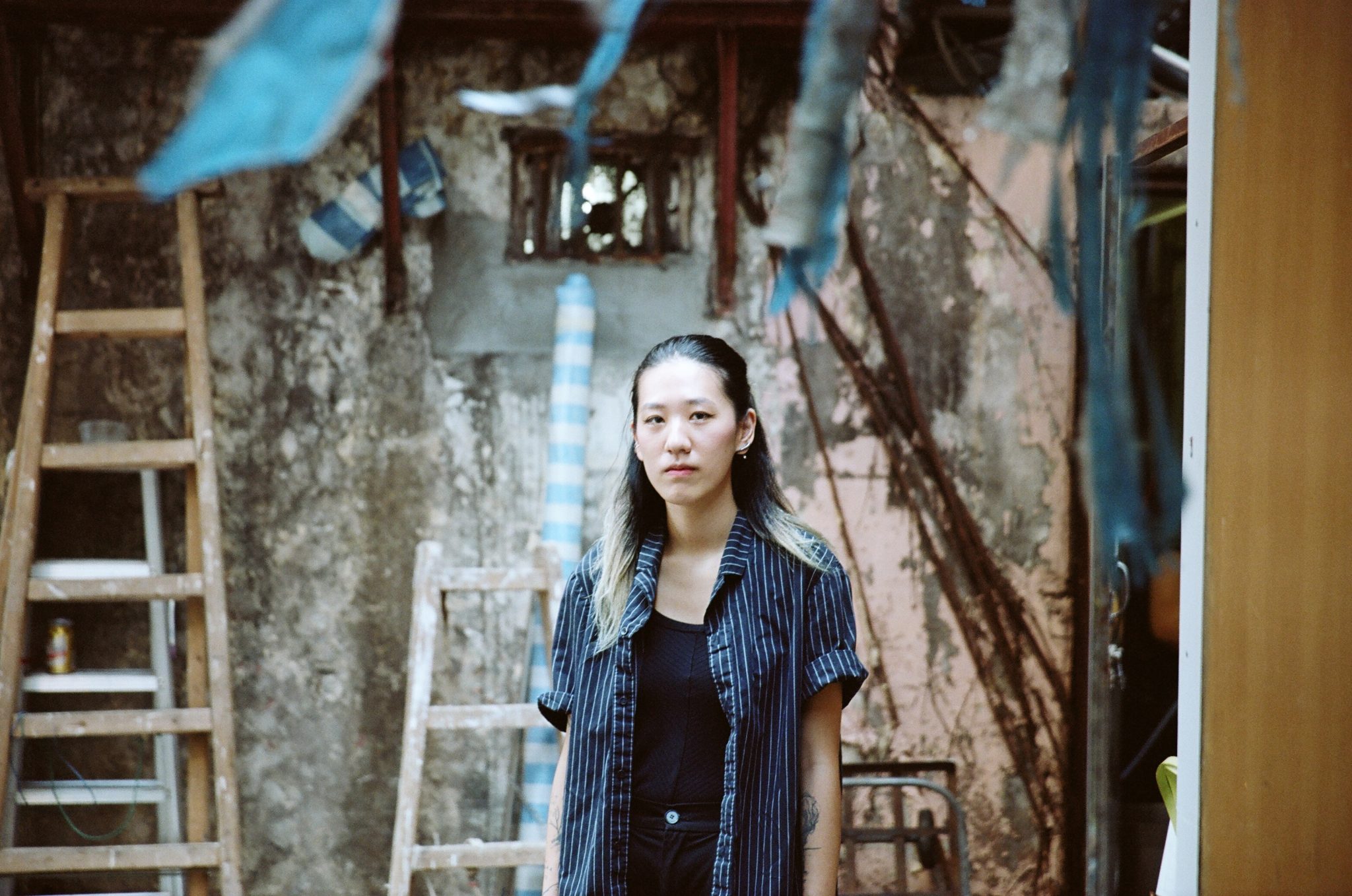The artist’s immersive installation facilitates moments of human connection, while ruminating on an anticipatory sense of grief
Michele Chu facilitates moments of human connection. Since 2016 she has, via various informal street interventions and public experiments, tried to find ways of creating intimacy between strangers: “poking at different boundaries”, as she calls it. These interventions are often playful: she has set up booths in public spaces and invited strangers to sit and make friends with her; held a bunch of mistletoe over strangers’ heads; started conversations using cue cards with diners through restaurant windows. More recently – since the COVID-19 pandemic – she has also conducted workshops in Hong Kong, during which the general public have been invited to explore grief. In 2021 Chu presented her first largescale installation, Inti-Gym (short for ‘intimacy gymnasium’) at Tai Kwun – Centre for Heritage and Arts in Hong Kong: two strangers could walk from either end, into a tunnel constructed from sheets of semitransparent netting stretched over metal frames and divided in two at the middle. Once seated at the dividing fabric wall, the strangers would find written prompts to get a conversation going; they might choose to reach out to each other by pushing their hands against the wall, and they might choose to reveal their eyes to one another through a cutout flap. Or they might choose not to do either of those things.
Chu is a designer by training, having earned a postgraduate degree in Global Innovation Design (which involves research into design solutions for social change, jointly awarded by London’s Royal College of Art and Imperial College). “I never anticipated becoming an artist,” she admits over a video call. “But in 2019 there was a lot going on in my family life, and then COVID-19 reached Hong Kong. I think intuitively I was very driven to use my hands to process emotions in some way, and so that’s how I started making artworks.”
For her debut solo exhibition, titled You, Trickling, on view through May at Hong Kong’s PHD Group gallery, Chu has created an immersive space that reflects on a personal loss that has not happened as yet, but will do so soon, and the associated feelings of anticipatory grief and emotional fragmentation that come with that. In it, the visitor is invited to move through a series of rituals before entering further into the exhibition space, where various objects made from fragments of glass, metal, family photographs and the artist’s own hair and fingernails are on display.
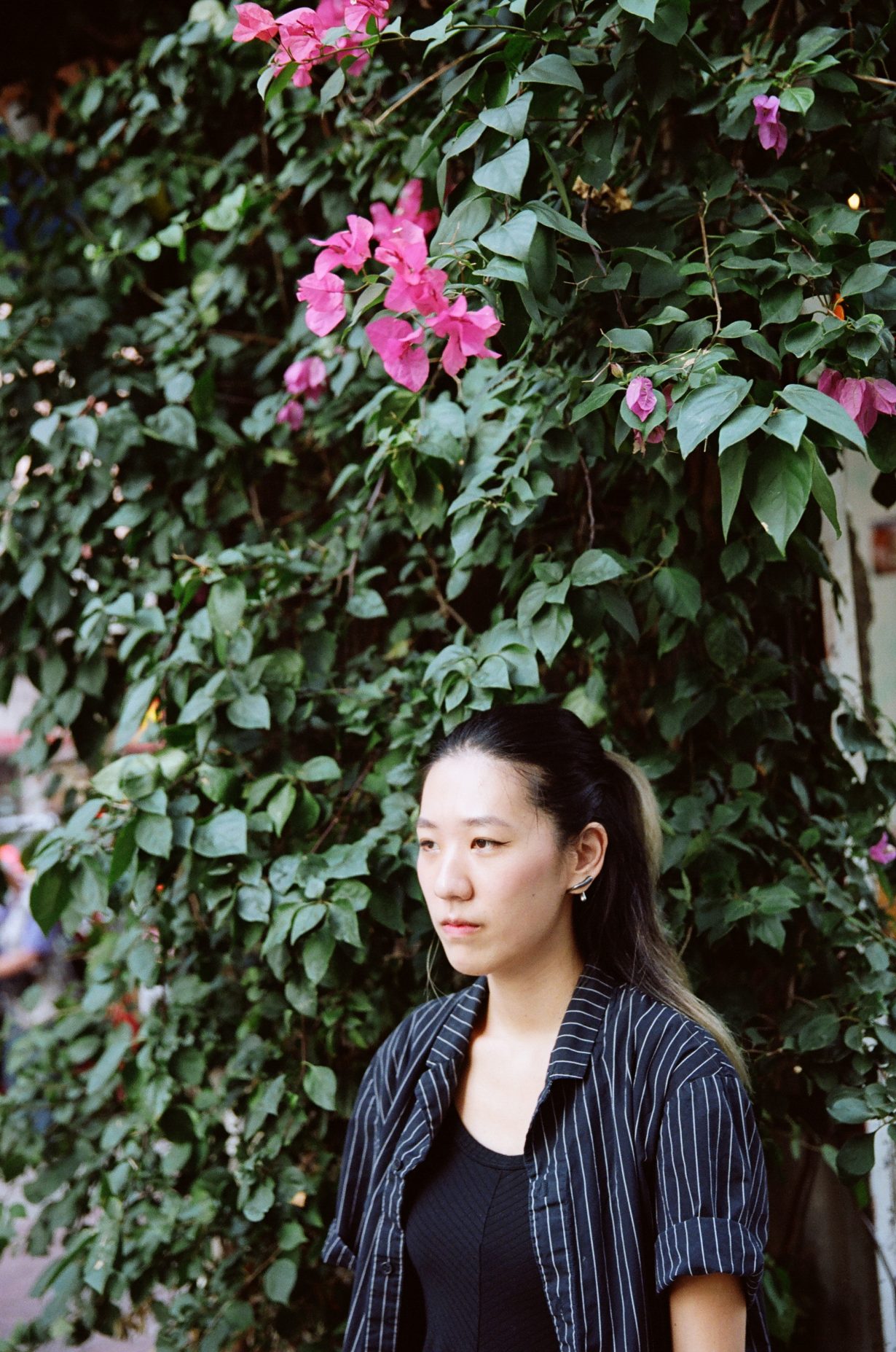
Intimate Distance
ArtReview Asia Your work is quite personal and, to some degree, experimental. Did you find it hard to explain to your family or friends what you were trying to do with your performances and experiments?
Michele Chu In the very beginning, yes, because it was also me confessing, ‘Oh, this is my fear of intimacy’. I feel very naked and vulnerable saying that in front of people, but owning up to that is also part of managing it.
ARA Have you figured out why you were – or are – afraid of intimacy?
MC It’s a fear of being hurt or rejected. [laughs] I think everyone goes through that. My walls got higher and higher. It got harder to trust people and to let people in – to the point that I realised it and then needed to try to change that. I think once you open up, it’s much easier for the other person to open up as well.
ARA I see this playing out in works like Inti-Gym. Is that what you intended?
MC Mostly I’m interested in how to make people feel safe, whether it’s through curating a space or creating a situation in which people can feel like they can be more present and also be vulnerable with another stranger.

ARA Does that sense of safety come from those thin barriers and boundaries in your installations and street experiments? I’m also thinking of your 2017 street experiment where you stopped in front of a restaurant window and held up question cards up to a person sitting inside. What results is this interaction through a glass pane. And it eventually leads you to enter the restaurant and share a glass of wine with the diner.
MC Usually we have very specific distances according to the type of relationship we have with another person, whether it’s public distance or intimate distance. I think having a physical barrier helps people feel safe because they can decide to opt in, or out of the interaction. In the case of Inti-Gym, you can’t pick up on participants’ expressions or any other physical cues that we normally pick up on in daily conversation. That, in a way, makes us more open. The fabric barrier is a kind of literal safety net.
ARA When did you start on the work you’ll be showing in Hong Kong?
MC The proposal for You, Trickling took a few iterations, and then I started fabricating works during recent months. It has changed a lot throughout this whole process. In the very beginning, I was inspired by the concept of the onsen and how these bathing spaces could be an emotional sanctuary. I was very interested in the cathartic effect it had on people, as well as the multisensory aspect of it.
Then that changed a bit, mostly because of my mum, who was given a terminal diagnosis. Her body can’t take any treatments of chemotherapy or radiotherapy anymore, and she’s in a lot of pain. The exhibition will still be a very experiential, multisensory journey for visitors, but it’s definitely taken on more of the themes of anticipatory grief, the passing of time and the body.
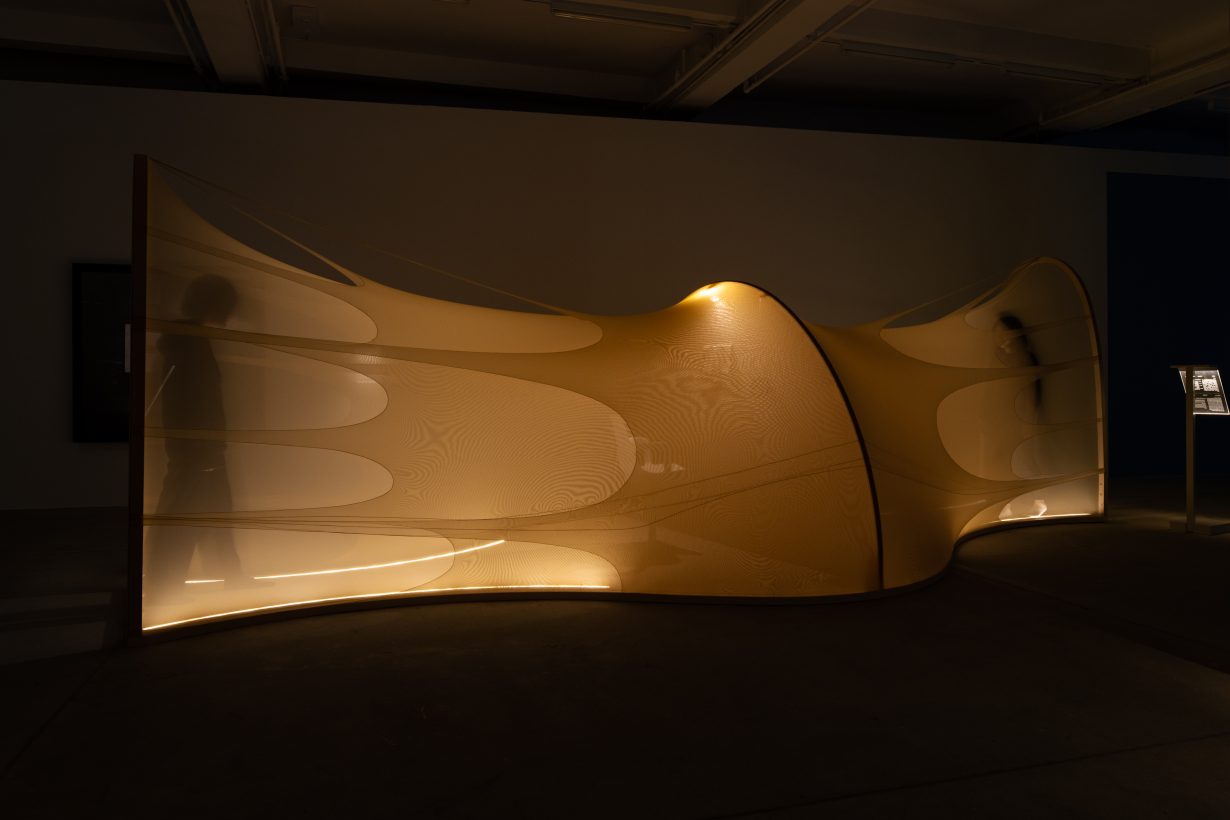
Titling Grief
ARA It’s a lot to process. Are you finding a way to do that?
MC I think that the processing of all those emotions is incorporated into my works: everything is still very fragmented metaphorically, but also literally. For one of the pieces, I’m making these glass chains (made from window glass); then I shatter them with a hammer and solder them into little pendants. Then I place emulsion lifts of photos I’ve taken of my family and myself on pieces of glass. In other pieces, I’ve used parts of me: my hair, fingernails, menstrual blood, even cigarette butts. Those things are cast in resin and linked as a chain.
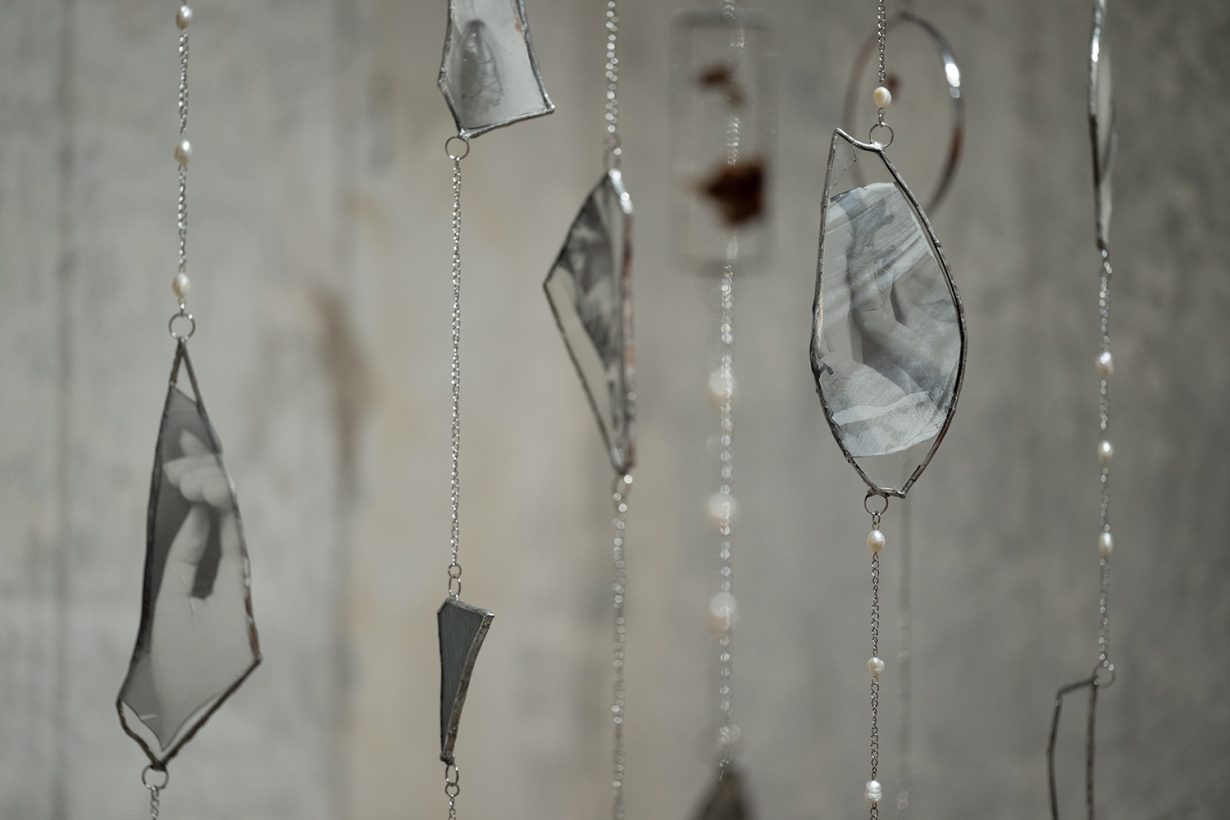
ARA Did it feel different making this series – as opposed to conducting those other experiments – because you had to be alone with yourself?
MC Yes. Even coming up with titles for this exhibition was very difficult. Processing with my hands feels more natural and more automatic to me. But coming up with the titles, with words, and trying to label them? When I was writing that out, I started to spiral because I was basically trying to label my emotions.
ARA That’s the interesting thing about the relationship between visual art, language and grief. It’s said quite often – and it’s true – that grief can’t really be assigned a written language: sure, you could technically write the words, but at the same time the words can’t be enough. Or, I guess, shouldn’t be enough. How do you encapsulate all of that in a title, or in a series of titles?
MC I did some automatic writing and stream-of-consciousness writing. I used my Notes app a lot! Basically, whenever I thought of something even if it was in the middle of my sleep or just when I was commuting somewhere, or just during any in-between times, I would jot it down. It was probably way more than a thousand words, but I just kept writing.
Willem and Ysabelle [Willem Molesworth and Ysabelle Cheung, the founders of PHD Group] knew that I was having trouble choosing, so Ysabelle proposed that we try this exercise where we physically cut up the words I wrote and then try to rearrange them based on, for example, a category for the body, a category for words relating to water and then a category with all the ‘you’s’ in it. It was a process of playing with the words physically, which really helped. That’s how the exhibition got its title, You, Trickling.
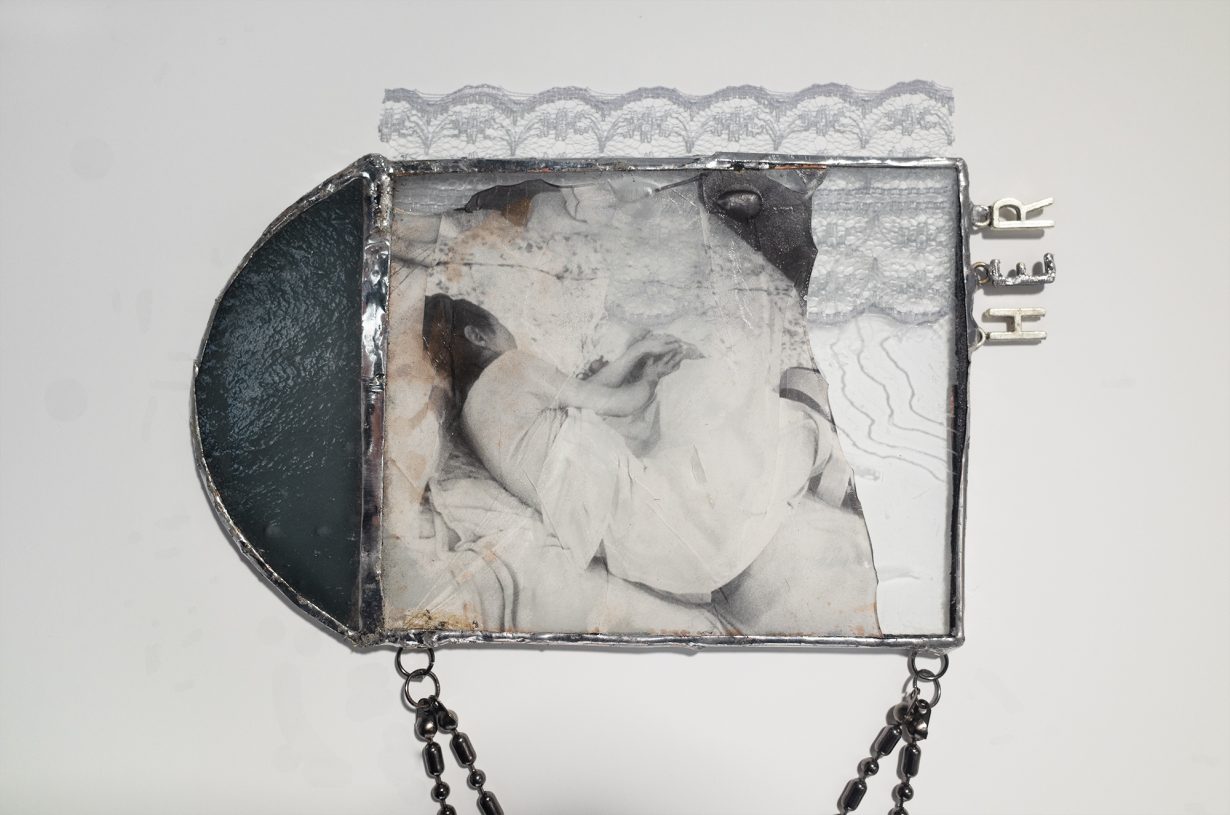
ARA I guess doing that exercise helps to distance yourself from the work. As if extracting the words from your writing also behaves as a kind of safety net. The title is in the present tense, which seems to reflect this liminal passage of time that you and your mum are experiencing.
MC Yes. It’s like this in-between stage where I can still call her up and talk to her, while also knowing that she will pass away soon.
ARA Do you find that it’s affected the way that you make art or the way that you approach intimacy now?
MC In terms of grief or anticipatory grief, I think once I open up about it, it also gives space – for example – for you and I to connect as well. Also, it makes me think of how we might care for each other on a communal level, which is also in a sense what I’m trying to do with this exhibition. In December 2021 I hosted a workshop, ‘How to Build a Multisensory Grieving Ritual’, with dancer Sudhee Liao. We explored the idea of how we might care for each other on a collective level during the process of grieving. Participants were teamed up with other strangers to design their own grieving ritual using design-thinking frameworks and rapid prototyping; we also provided props and storyboarding techniques. At the end of the workshop, participants would perform their own grieving ritual followed by a discussion around their thoughts and feelings.
I think that was helpful because I feel like in Hong Kong there’s an undercurrent of loss. A lot of people came up to me after the workshop to say there’s nothing else like this in Hong Kong and that they really needed this. There’s really no instruction manual or anything on how to process these types of emotions.
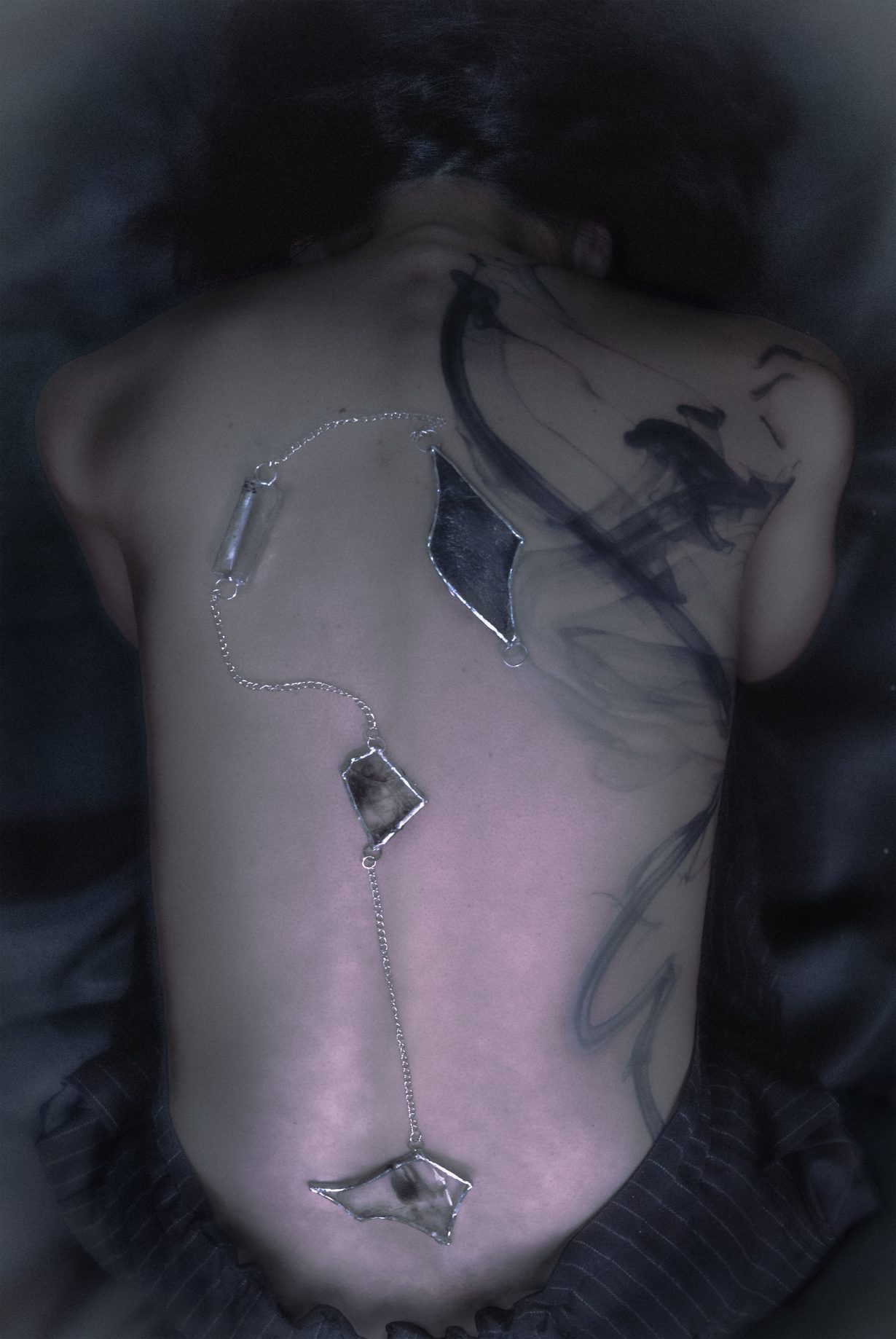
Courtesy the artist and PHD Group, Hong Kong
Please Touch
ARA Hong Kong is a very ritual-based society, not just around festivals, but around everyday superstitions and significant life events as well. Did you find, in making this new body of work, your own kind of ritual?
MC Yes. I think it’s my ritual but also designed for others to experience as well. For example, when people enter the exhibition space through a curtain, there’s a fog shower between two doors that serves as a kind of ‘mood palate-cleanser’ – a sort of in-between state, from the outside world to the space inside the gallery. I’ve also installed heat lamps so the temperature of the space changes, and there’s a sound installation that incorporates a ritual where visitors burn incense and walk around in a circular, meditative journey before viewing other glass or metal works. I feel like having these ‘nudges’ will allow visitors to ease into that calm state of mind to view my works.
ARA There’s the idea of boundaries here, too. You’ve made something that’s very personal and private to you, and you’re putting it out to the public. You’ve set up these physical thresholds for visitors to encounter but there’s also the threshold between the visitor and yourself.
MC I think having the exhibition at PHD gallery really suits it, because entry is by appointment only, and so it’s a much more intimate setting. I’ve also sectioned off the gallery space with thin curtains to create these pockets of space through which you can meander. It’s like playing with private and public spaces, kind of like the changing rooms at an onsen.
ARA How about the presence of water in this exhibition – it has a cleansing aspect of course, but it’s also often used as a metaphor, right?
MC People often talk about grief in terms of water: ‘it comes in waves’, or it’s ‘bottled up’. For me, right now, it’s like an unpredictable tap that will suddenly pour. I read this Reddit thread on grief. People say that when it comes in waves, at the beginning it sometimes comes in 100 feet tall, but then, later on, the time between each wave is further apart and the height of the wave might also decrease. But you can never know for sure how high it is or what the interval between each wave will be. Sometimes you’re clutching onto a log or something, to hold onto a specific memory.
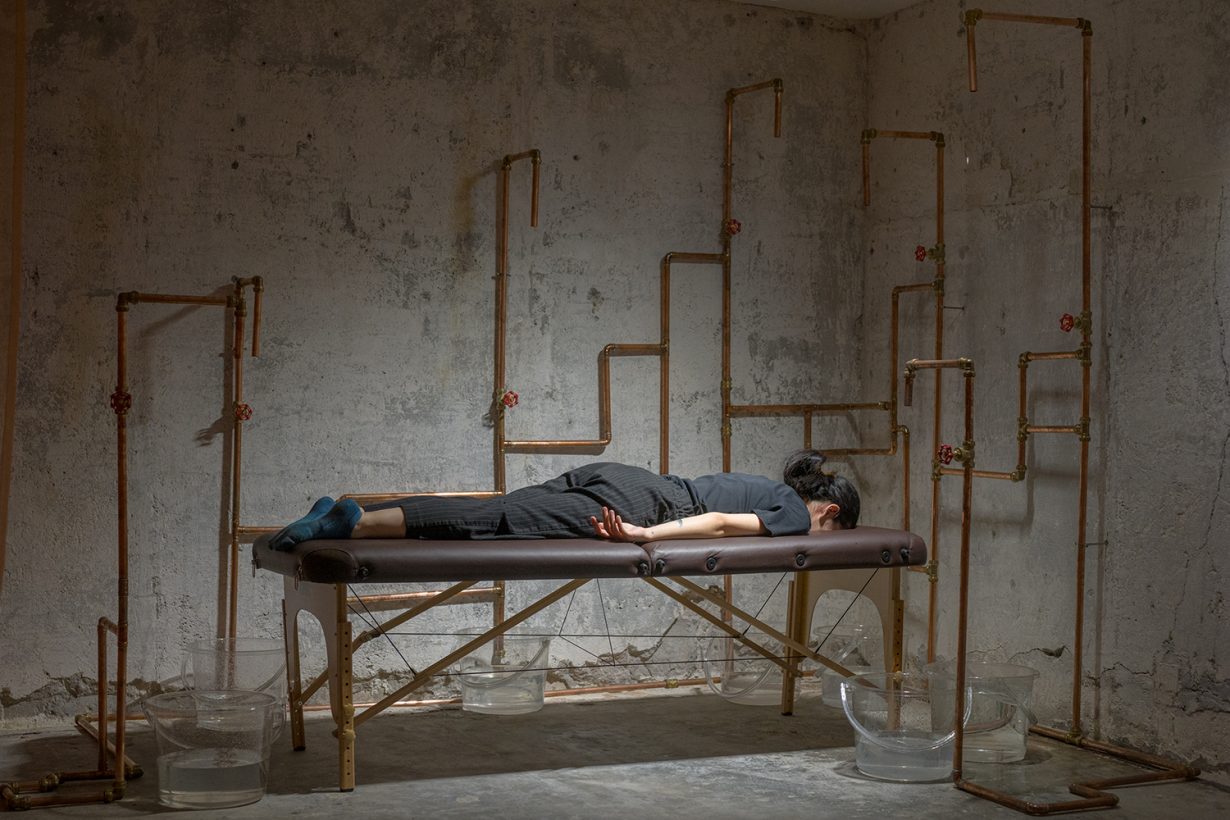
ARA Do you find that water relates to the state of anticipatory grief, too?
MC There’s a work in the exhibition called Seeping, and it’s a water installation. Water is a very charged medium. Basically, the visitor lies down on a massage bed, around which water buckets are arranged. Water drips into different buckets, but the visitor doesn’t know when the water is going to drip, or how slow or how fast the water is dripping. That work pertains to the uncertainty of grief, but also seeping emotions.
ARA Does your mum know much about the exhibition?
MC She knows that my exhibition is about her, but she doesn’t specifically know what I’m making yet. We’ve had conversations as well, while I was making a glasswork with hair, where she related to it in terms of her experience with cancer and the loss of hair.
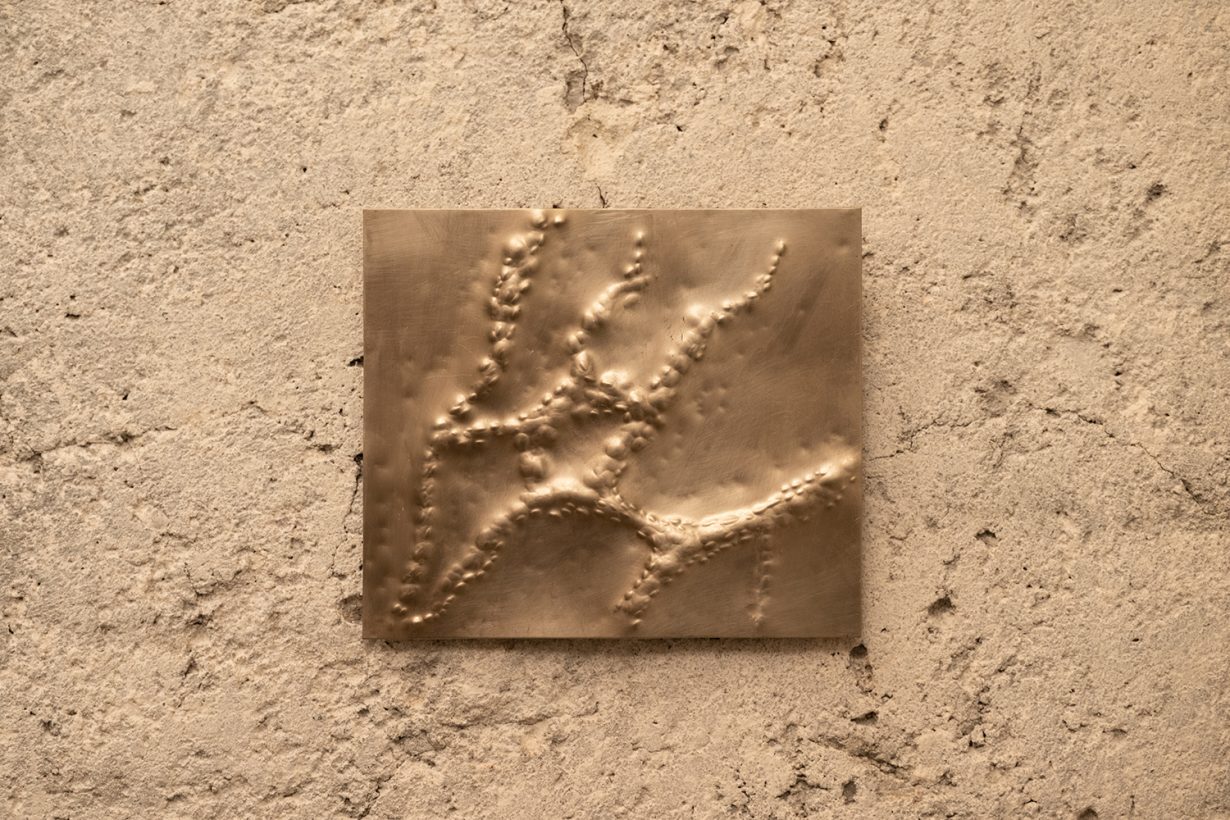
ARA That must be difficult.
MC I recently read this piece of writing by Elena Barnabé called Grandma, how to deal with pain?, which I now keep on my phone. It’s about dealing with pain using our hands. ‘Our hands are the antennae of our soul. When you move them by weaving, cooking, painting, playing, or sinking them into the ground, they send signals of care to the deepest part of you and your soul calms down… Everything that is made by hand is said to be made with the heart… the hands and the heart are connected’. I really resonated with that piece.
ARA Again, it’s that thing of translating love into action. A bit like how Chinese parents will give you a plate of cut fruits, and that’s like a sign of affection or an apology.
MC Yes. Related to the repetitive action involved in cutting a piece of fruit, I’m using the technique of metal repoussé in one work: I’m repetitively hammering out a low relief form, tracing the pattern of my mum’s blisters and rashes that came out when she was doing chemotherapy. In a way, it’s quite intimate, like when you’re using your finger to trace a pattern on someone’s skin or something.
ARA That act of hand-recording these marks is quite different to documenting them through, say, photography or video. You mentioned, quoting Barnabé, that the hands and the heart are connected; it’s almost as if in recreating these marks on your mum’s body, you’re finding a way for your own body to process grief as well.
MC Right, yes, that’s a good way to put it. I’m forging a memory onto the material. And also forging that memory into myself, through that action of hammering.
ARA Do you remember the last piece of fruit your mum cut for you?
MC Peaches. In July. Last year.
You, Trickling is open by appointment at PHD Group, Hong Kong, through 13 May
